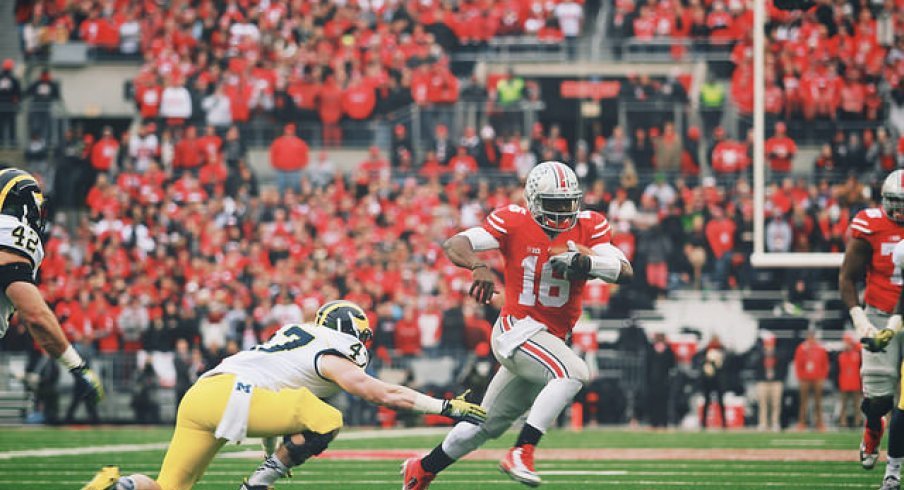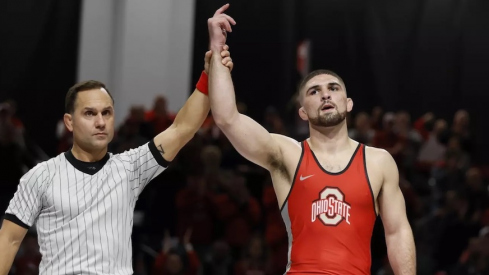With new defensive coordinator Don Brown taking the reins of a Michigan unit that was gashed for 369 yards and five touchdowns on the ground in a late-November 42-13 shellacking, expect the yards to be harder to come by this time around as he implements a new approach to stymying Ohio State's Tight Zone.
As Kyle Jones wrote after Brown’s hire date this past spring, what the aggressive coach lacks in name recognition he more than makes up for with on-field performance.
Under Brown’s tutelage—and despite finishing the season with a 3-9 record—Boston College led the nation in total defense last season while finishing second to eventual national champion Alabama in rush yards-per-attempt (2.39). The squad allowed 112 total rushing yards against national runner-up Clemson and their Heisman trophy-finalist quarterback Deshaun Watson, while holding future first round draft pick Dalvin Cook (Florida State) to 54 yards on 15 carries.
Stopping the run is clearly a cornerstone of the new coordinator’s defensive philosophy. Running the ball has been Ohio State head coach Urban Meyer’s calling card since his first head coaching job at Bowling Green University. Something has to give.
The Buckeye’s diverse running attack is rooted in the bread-and-butter ‘Tight Zone’ concept.

As discussed in previous film studies, a primary key to the play’s success is the ability to ‘read off’ a backside defender, often a defensive end or linebacker. This option concept enables the offense to rebalance box numbers in their favor by eliminating an in-the-box defender from the play without assigning a blocker, a huge advantage as they can theoretically create a numbers advantage at the point of attack.
A great part of the offense’s success can be attributed to junior quarterback J.T. Barrett’s superior decision making. Over two seasons the team captain has consistently demonstrated the ability to make correct reads when running Tight Zone, whether handing the ball off to former all-world tailback Ezekiel Elliott or pulling the ball to run around the corner on the quarterback keep.
Barrett’s skillset culminated with the aforementioned destruction of first-year head coach Jim Harbaugh’s Michigan squad in a highly-anticipated matchup that quickly became a rout after three quarters of football. Ohio State was able to run at will on the Wolverine defense to the tune of 6.8 yards per attempt and five touchdowns, in large part by exploiting a common defensive technique used against their base Tight Zone.
Many defensive linemen are coached to follow a ‘block down, step down’ rule in order to squeeze (reduce the size) their assigned gap when the blocker across from them releases inside to execute a down block, scoop, or jump-through. Against an Inside Zone-based offense the general technique is to follow the hands inside and attempt to disrupt the lineman’s path as he climbs to the second level to block a linebacker. By replacing the blocker’s hip, the defensive end will naturally pinch towards the quarterback/tailback mesh point, often with disastrous results if the quarterback pulls the ball.

Focus on the play-side defensive end (#43) as he reads the right tackle's jump-through to the second level and bends inside to disrupt the block. Because the WILL (#35) mirrors the tailback’s path to his B-Gap responsibility, a large running lane is created for Barrett to exploit with a pull. With no help coming from the outside, the defensive end is put in a very difficult position as he is expected to disrupt the jump through, squeeze the C-gap, and play the quarterback bootleg.

Despite iffy perimeter blocking, the Heisman trophy candidate is able to turn the corner for a solid first-down gain.
So how will Michigan’s new hire attempt to stop (or at least slow down) Ohio State’s potent Tight Zone?
Defensive coaches have adjusted to option football using a variety of techniques since the concept hit the college football scene in the early 2000s under innovative minds like former West Virginia and Michigan head coach Rich Rodriquez. Techniques such as run slants based on alignment and gap exchanges in which a linebacker and defensive end switch gap responsibilities post-snap quickly emerged as the top ‘option beaters’.



In the never ending game of adjustments, offenses reacted to run slants by utilizing gap-blocked concepts away from the slant direction and changing the read man against scrape exchanges. In response, the ‘Squeeze and Pop’, or 'PUP' technique, has quickly become the hottest go-to concept to defend option football.
Via Chris Brown's outstanding Smartfootball blog, the Wolverines' progressive coach analyzed the basic tenets of the technique at Michigan’s 2016 coaches clinic:
Defending the Spread Run Game: In terms of defending zone option, Coach Brown will use a PUP technique for his defensive ends, also commonly referred to as squeeze and pop. The defensive end being read will play the QB and the bend (RB cutback) on zone. The unblocked defensive end will stay square and shuffle flat down the line of scrimmage to close the space on any zone cutback. If the Quarterback keeps the ball, then the defensive end is chasing the QB from the inside out to his help. Coach Brown stressed that you have to get the defensive ends help versus zone option. You can’t just assign the DE to the QB with no help and expect him to take away the zone cutback and be able to run down a Quarterback like Deshaun Watson.
Although Brown will use a variety of techniques (including the scrape exchange) based on coverage and alignment to stop the option football game, a look at Boston College’s 2015 film shows the ‘Squeeze and Pop’, over and over.
Before going to the tape, it is important to separate the differences in technique and responsibility of the PUP against a traditional ‘pinch’ technique.
Like most techniques in football, it all starts with the stance:

Notice the athletic demeanor of the ‘read’ defensive end (#93). His hips are low (eyes and nose over the toes), his feet are shoulder-width apart, and his arms are out to create a solid center of gravity for balance. When the defender recognizes he has become the 'option' player, he will execute the stance and shuffle laterally down the line of scrimmage towards the mesh point using quick steps. The defender should keep his shoulders parallel to the line of scrimmage in order to allow a ‘two-way go’.
The read man’s responsibility is two-fold: He must squeeze inside under control in order to play a cutback by the tailback while still remaining in position to play the quarterback pull, with help from a secondary force defender (often a defensive back).
Let’s go to the tape to take a look at how the technique plays out using a clip from Boston College’s 34-17 loss to the Clemson Tigers.

There are several moving parts here so we will break down the PUP technique in steps.
Start with the concept recognition. As soon as the left defensive end recognizes the right tackle’s climb the second level, he immediately enters his stance and squeezes the backside C-Gap under control with quick, lateral steps.
Next, move to the safety at the bottom of the clip (#9). Again, concept recognition is key as the defensive back is the leverage player to help the end play a quarterback pull. We can see that rather than come downhill into the scrum, he clearly shoots outside to help if Watson pulls the ball and bootlegs around the corner.

The wide view shows another angle of both players acting as a lever to attack the quarterback from both sides while allowing the defensive end to maintain cutback responsibility on the tailback.


Compare and contrast this clip to the previous clip showing the Michigan player pinch inside to the mesh point. The Boston College defender’s leverage and technique put him in position to play the ball carrier’s bend and make a tackle at the line of scrimmage while simultaneously keeping the ball out of Deshaun Watson’s hands in the open field. Meanwhile, the Michigan defender’s leverage allows Barrett to pull the ball and turn the corner for a solid gain.
We see the technique in action later in the same game:

The option defender reads and recognizes his run key (the right tackle’s down block), executes the technique, and again makes the tackle when the tailback attempts to bend the ball backside. Notice the safety’s (#27) initial path as he widens to play the Watson pull before shooting back downhill to play the tailback, following the principle of attacking the quarterback both inside-out and outside-in to surround him with would-be tacklers.
We can see the technique from a different angle in our next clip:

Discipline is clearly key to consistently executing the technique.
What does the squeeze and pop look like when the quarterback pulls the ball to bootleg around the corner?
Going back to the Eagles' 17-14 defeat at the hands of the Louisville Cardinals, we see outstanding concept recognition and execution of the PUP technique as defensive lineman Mehdi Abdesmad (#45) makes a bone-jarring tackle on quarterback Lamar Jackson.

Abdemad’s athletic stance, square squeeze down the line of scrimmage, and lateral steps allow the 286-pound defensive end to make the play against a speedy quarterback in space by maintaining his inside-out leverage with outside help coming from the safety (#27). This is a great example of sound, leverage-based tackling to bring the ball carrier to the ground.
Expect a new look from Michigan’s defense this fall as Brown installs his aggressive, progressive brand of run defense. Three-time national champion Urban Meyer and his offensive coaching staff certainly know what is coming their way. Based on previous results during Meyer’s tenure, the greatest rivalry game in sports will likely come down to who makes the right counter at the right time, in a case of “last coach at the grease board wins”.


